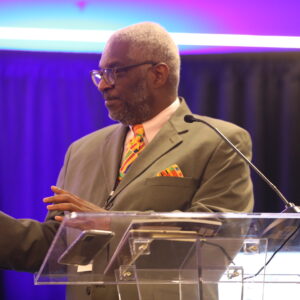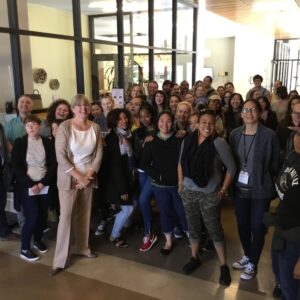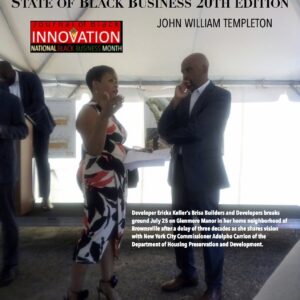Description
On the anniversary of the birthday of Maya Angelou and the murder of Dr. Martin Luther King Jr., we were confronted with the news that a rogue administration is attempting to delete African-American history, including the Underground Railroad. For the past 45 years, John William Templeton has been a subject matter expert for the National Park Service and state historic preservastion offices. As the first journalist to write about President Ford’s proclamation of Black History Month in January 1976, he set in motion the process that constructed the Schomburg Center for Black Life and Culture in Harlem in 1981; he wrote the Roots of Black Winston-Salem in 1978 as editor of the Winston-Salem Chronicle and was the editor of the first Black newspaper to mark a centennial at the Richmond AFRO-AMERICAN. As a graduate research associate at the University of North Carolina’s Southeastern Black Press Institute, a joint project of the Black Studies program and School of Journalism, he completed a oral history of the Black press from Georgia to Maryland and produced the first documentary on the Black press for the UNC Television Network, We Wish to Plead Our Own Cause.
In Richmond, he chaired the Jackson Ward Project Area Committee, which implemented the largest Black business National Historic District in the nation including the Black History Museum of Virignia, which represents the best example of preservation of a historic Black neighborhood 40 years later.
Templeton made history even as a youth as senior patrol leader of the first Black troop to integrate Camp Schiele, South Carolina in 1967 and as first Black student at D. Matt Thompson Junior High School in Stateseville, N.C. A member of the golden class of 1975 from Howard University, his lifespan has covered the entire period since the Brown v. Board of Education decision.
Following the beating of Rodney King, he edited Our Roots Run Deep: the Black Experience in California, Vols. 1-4, a 1,400 page compendium of the Golden State’s history since 1510, in 1991. It has been a textbook in California schools for 35 years, without a single complaint. In 2008, he was keynote speaker for the California Council for the Social Studies presenting a commissioned research study, Black Heritage as Gap Closer: Capacity of California Social Science Educators to Teach Culturally Responsive Lessons after having edited in 2001 the report of the Commission on Research in Black Education study Facing the New Millennium: A Transformative Research and Action Agenda in Black Education. In 2004, he presented the first Black history exhibition in the California State Capital at the invitation of Assemblywoman Barbara Lee, D-Oakland, named for Our Roots Run Deep. which highlighted the Capitol mural in Room 405 of Queen Calafia, the Amazon warrior queen who gave Caifornia its name.
The challenge of noting that the nation’s largest state was named for a Black woman caused Templeton to ponder the pedagogy of infusing Black life into school curricula. As editor of the patron saint of Caribbean intellectual’s Sylvia Wynter’s, book, Do Not Call Us Negroes: How Multicultural Textbooks Perpetuate Raicsm, he learned how she practised the findings of Dr. Franes Cress Welsing and Dr. Carter G. Woodson to discern the immobilzing intellectual impact of the six steps of racism.
With those tools, Templeton has created ReUNION: Education-Arts-Heritage, the largest African-American curriculum provider in the nation, with more than three dozen textbooks and reference sources along with integrated learning system, 4Real, based on the General History of Africa and the General History of the Caribbeaan from UNESCO After Our Roots, he compiled the history of every state that ratified the three Reconstruction manedments. The books are:
Road to Ratificaton: How 27 States Faced the Most Challenging Issue in American History
Citizenship for All: 150th anniversary of the 14th Amendment and,
We Fought, We Vote: 150th anniversary of the 15th Amendment.
These are the result of his second exhibition in the Historic State Capitol, Gold Rush Abolitonists: California and the 13th Amendment. After interpreting a nine-foot reproduction of the California adoption of the 13th Amendment, found in a closet after 150 years, he set out to find every such document of ratification by state legislatures of the 13th, 14th and 15th Amendments. The result is a complete legislative history of the greatest exhibition of democracy in human history and the most unifying period of American history.
Accordingly, the premises of the recent executive orders are completely counter-factual. African-American history is the connecting tissue of American life and the most respected narrative globally. In 52 years as a practicing Black historian and author, Templeton has never had to apologize or back up on the centrality of the Black experience to global history.
In 1994, he unspooled a thread of family history to write Grampa Jack’s Secret, which traced his family back to Mali in the 1400s. He was designated by the Amiru Songhoy, the direct descendent of Askia Muhammad, ruler of the Songhoy Empire, from which 75 percent of African-Americans are descended, as wanadu aroo, or history advisor. That deep knowledge is necessary for teaching through cultural mastery, the antidote to any attempts at backlashes. Templeton was consultant to the ethnic studies task force of San Francisco Unified School District under its Teaching American History grant in 2008, which led to the State of California requiring ethnic studies courses beginning with 2024. In 2020, he presented for the Innovating Equity conference of the California Department of Education at Disneyland.
He uses the 6,000 site California African-American Freedom Trail as a platform for expeditionary learning among California learners. During the 2025, the Culture Fridays effort he has led for 10 years will be headquartered at the new trailhead for the trail at Fisherman’s Wharf in TheSargent: Sargent Claude Johnson National Museum of African-American Art, the sixth museum he has helped create.




